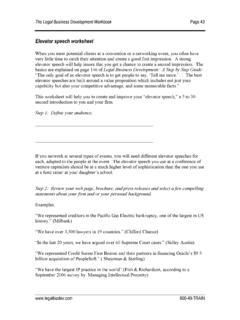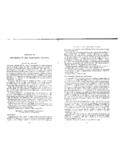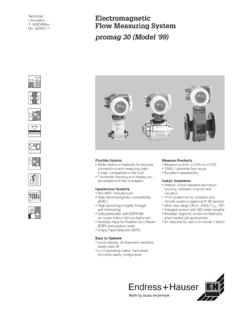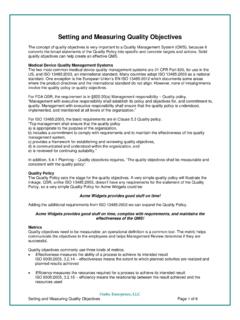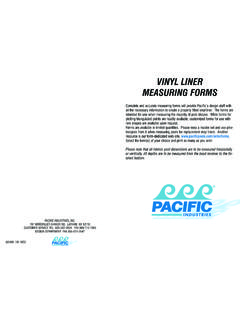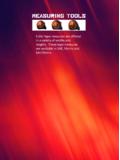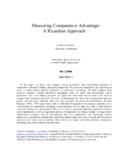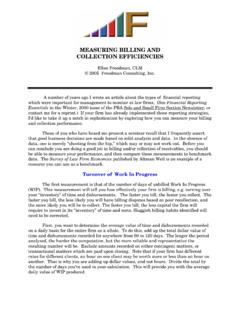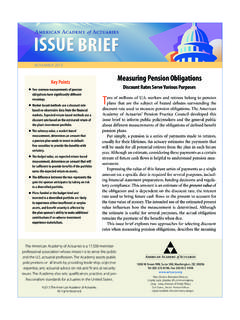Transcription of Measuring Law Firm Profitability - LegalBizDev
1 Of Counsel, October 20146 This article was adapted from the new book Client Value and Law firm Profitability . For more information, see or call on our confidential interviews with managing partners and other leaders from 50 AmLaw 200 firms, there can be no ques-tion that clients are demanding more value than ever before, and that is putting pressure on the bottom line. There is, however, much less agreement about the best way to measure the bottom line. There are many problems in relying on profits-per-equity-partner, realization, lever-age, and other traditional measures. So it may seem obvious that the way out of all this confusion is to move toward the approach used in almost every other business: applying cost accounting to measure profit.
2 The basic formula looks deceptively simple:Profit = Revenue CostCost accounting establishes rules for defin-ing both revenue and costs, but it s not as simple as non-CPAs might think. Cost-Plus ModelBefore we started working with law firms, my company spent almost 20 years develop-ing training programs for financial services clients and for government agencies. Many of the government contracts we worked under were cost-plus, in which an hour of a per-son s time must be billed at its true cost as defined by many pages of government accounting rules plus a negotiated fixed fee. (In our experience, the negotiated fixed fee on government contracts was typically between 3 and 5 percent of cost, which seems laughable by the standards of many law firms.)
3 So you d think that, if anyone could iden-tify the true cost of labor, it would be a gov-ernment we gradually learned that government contractors have a number of options for calculating both the direct cost of what a person is paid per hour and allocating the indirect costs of benefits, rent, general and administrative overhead, and so on, to dif-ferent groups within the company. There was no single number for the true cost of a particular hour of labor, despite all the rules and regulations. The answer depended on a number of assumptions and interpretations. Still, many law firms see cost accounting measurement of profit as the Holy Grail, with potential benefits to both themselves and their clients.
4 As ACC Value Co-Chair Michael Roster summed it up: Once a firm or practice group shifts to a true Profitability set of measurements, the firm finally has incentives to: Keep reducing its cost of production meaning moving matters to those with appropriate expertise while lowering leverage and hourly rates, where hourly rates are now used to monitor the cost of production, not how to maximize what can be billed Measure and deliver better outcomes and be rewarded for that Learn how to fix the cost of any given type of work Along the way, improve profitabil-ity (Michael Roster, Facing Up to the Challenge: Law firm Metrics, Association of Corporate Counsel (2013), , 7.)A Persistent Challenge: Measuring Law firm Profitability7Of Counsel, Vol.
5 33, No. 10 The Law firm ExceptionHowever, in one leading text on law firm accounting, CPA John Iezzi explained that, in working with law firms, he learned that it s much, much harder than it sounds:My first article [on law firm profit-ability was] .. written in 1975 .. after I had recently left public accounting, convinced that one could apply the same cost-accounting techniques to the service profession as one did to any other industry. [However], this was not the case, as I later determined once I began attempting to apply various cost-accounting practices to the legal profession. (John G. Iezzi, Results-Oriented Financial Management: A Step-by-Step Guide to Law firm Profitability , American Bar Association, 2003, 125)The result for many firms is that, as one managing partner admitted:We struggle with a standard profitabil-ity model, and we don t really have one right now.
6 Another managing partner pointed out the underlying problem:There s really more art than science as to what you count as revenue, and simi-larly what the cost allocations are going to be. Lawyers will debate all day long about those things. So it s important to have uniform or reasonably well-accepted best practices for Profitability analysis. I don t think our practice is there far as we can tell, neither is anyone else. When I talked to several members of our Research Advisory Board about this issue, Don Ware, chair of Foley Hoag s Intellectual Property Department, said:I ve never heard of a law firm that has a good way to measure matter profit-ability. Many say they do, but when you push on the details it becomes clear that they really don s not for lack of trying.
7 A growing num-ber of software programs are available to handle the calculations. The two long-time leaders in the field, Intellistat Analytics from Data Fusion and Redwood Analytics from Aderant, have been providing sophisticated tools to quantify law firm Profitability for several decades. But to use these tools, one must make a series of assumptions, and that s where the trouble one recent conference, Jeff Suhr, vice president of products at Data Fusion, noted that his company currently has 91 clients actively using their tools, including 10 of the top 35 AmLaw firms (Jeff Suhr, Best Practices in Leveraging Profitability Analysis to Better Price, Staff and Manage New Engagements, Presentation at the LMA P3 conference, Chicago, May 13, 2014).
8 Exactly how do these 91 clients calculate profitabil-ity? Ninety-one different ways. The funda-mentals are the same, but there are important differences in the details that can have signifi-cant implications for the way Profitability is interpreted and used to motivate changes in distinguished between the relatively straightforward science of calculating profit-ability and the art of determining the exact methods that best fit the needs of each firm . He also discussed the different challenges of macro strategies for analyzing profits for a firm , an office, or a practice group, versus micro strategies for analyzing a book of business or a particular matter. Different assumptions and different approaches are sometimes required.
9 For starters, you would think it would be easy to measure the revenue associated with a matter, but it s not. Iezzi s text notes that:There are three different revenue num-bers you can use. One is the accrual basis revenue number, which is hours worked multiplied by hourly rate. The Of Counsel, October 20148second is the bills rendered number. And third is the cash receipts number. (Iezzi, Financial Management, 132)The first two numbers reflect theoretical revenue. After client write-offs and write-downs, a significant amount of this revenue may never be received. So a Profitability sys-tem based on either accrual or bills rendered rewards lawyers for putting in more hours even if they produce no revenue. Dumping GroundIt is particularly troublesome with fixed fees and other AFAs where lawyers with too little to do may pile on the hours since it costs nothing and could help the client rela-tionship.
10 Not to mention that in many firms attorneys get paid more if they bill more hours, whether the client ever writes a check for the hours or not. In the LegalBizDev Survey of Alternative Fees (118), one AmLaw 100 decisionmaker told us that:It often happens that alternative fee matters, particularly large ones, end up being a dumping ground for individuals who may not be fully employed because you are reportable to the client for the result, not the cost. When lawyers work unnecessarily on a project your profit-ability looks bad, so in order to really determine the Profitability , we need to deal with that issue. As one chair in this research put it:What you re trying to do internally is change the mindset of the attorney who is used to billing hours.



